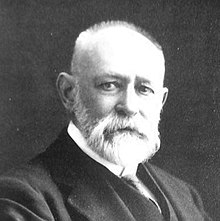|
Ernst Hartert
Ernst Johann Otto Hartert (29 October 1859 – 11 November 1933) was a widely published German ornithologist. Life and careerHartert was born in the Free and Hanseatic City of Hamburg on 29 October 1859. In July 1891, he married the illustrator Claudia Bernadine Elisabeth Hartert in Frankfurt am Main, Germany, with whom he had a son named Joachim Karl (Charles) Hartert, (1893–1916), who was killed as an English soldier on the Somme.[1]  Together with his wife, he was the first to describe the blue-tailed Buffon hummingbird subspecies (Chalybura buffonii intermedia Hartert, E & Hartert, C, 1894). The article On a collection of Humming Birds from Ecuador and Mexico appears to be their only joint publication. Hartert was employed by Walter Rothschild, 2nd Baron Rothschild as ornithological curator of Rothshild's private Natural History Museum at Tring, in England from 1892 to 1929.[1] Hartert published the quarterly museum periodical Novitates Zoologicae (1894–39) with Rothschild, and the Hand-List of British Birds (1912) with Francis Charles Robert Jourdain, Norman Frederick Ticehurst and Harry Forbes Witherby. He wrote Die Vögel der paläarktischen Fauna (1910–22) and travelled in India, Africa, and South America on behalf of his employer.[1] Although Hartert supported the conservation of some species of birds, he wrote a pamphlet in 1900 in which he supported the control of house sparrows.[2]  In 1930, Hartert retired to Berlin, where he died in 1933.[3] Hartert had been a mentor to Erwin Stresemann, whose cremated remains were interred at Hartert's grave in 1972.[4] WorksAmong the written publications of Ernst Hartert are:[5]
EponymsA species of lizard, Hemiphyllodactylus harterti, and 12 birds are named in his honor.[6] See alsoReferences
Sources
Further reading
External links
|
||||||||||||||||||||||||||
